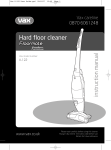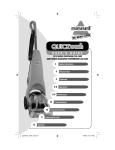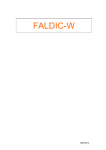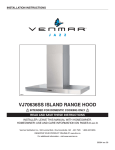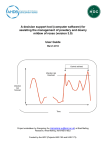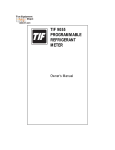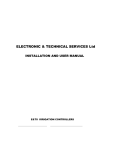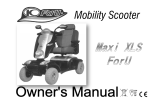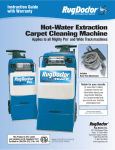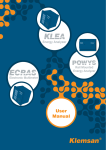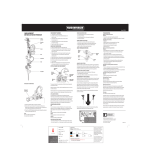Download Using the Evapometer to regulate irrigation v4
Transcript
S S WATER & AIR How to use the Skye EvapoMeter to regulate irrigation Guidance notes for nurserymen testing the EvapoMeter as part of the Hort LINK project HL0132 (Improving the control and efficiency of water use in container-grown hardy ornamental nursery stock). Dr Richard Harrison-Murray, HRI East Malling, 9 July 2002 Introduction These notes are intended to complement the user manual provided by Skye Instruments. The Skye manual tells you how to get data from the instrument; these notes suggest how you can use that information to decide how much irrigation to apply (i.e. as a tool in irrigation management). The EvapoMeter allows you to estimate how much water the crop is using so that you can apply just enough to replace what has been lost, without wasteful over-irrigation. In particular, it should take the guesswork out of adjusting irrigation timers to allow for day to day variations in the weather. The evaporative demand of the atmosphere sets an upper limit on the amount of water a crop can lose by transpiration from the leaves combined with evaporation from the medium (the 'potential evapotranspiration', ETp). The output from the evaposensor (i.e. the temperature difference between the wet and dry 'leaves') is proportional to evaporative demand. The EvapoMeter integrates this output over time and displays the results in degree hours. These values have been shown to correlate closely with more complex methods of estimating ETp. However, to use them to regulate irrigation, a 'calibration factor' is needed which takes account of crop-related factors (species, plant size, spacing, etc.) and irrigation-related factors (application rate and the proportion that reaches the plants). Data collected in the course of the project indicate that 1 mm of ETp from a standard reference crop (grass) corresponds to the accumulation of about 24 degree hours on the EvapoMeter. However, it would be unwise to use this conversion to estimate how much irrigation to apply because it takes account of neither crop factors nor irrigation factors. Such a conversion factor could be built into the instrument but this might encourage users to believe that calibration was unnecessary. Future versions may provide this option and/or the option to install a user-determined calibration factor. There are many ways in which an appropriate calibration factor could be derived. The simple procedure described below should not take long and will often provide useful insights about differences between crops, etc. In one operation, it takes account of effects due to crop, stage of development, pot size and spacing, and both the rate of application of irrigation and the proportion that reaches the pots (rather than running to waste between the pots or on roadways). Two different versions of this approach are described. Method A involves weighing a sample of plants to monitor, first, plant water use and, then, water gain during irrigation. Method B relies on the user's ability to judge from experience when the correct amount of irrigation has been applied. Note that the calibration feature described in Section 4.2 of the Skye manual has a quite different purpose. It compensates for any difference between the thermistors in the two 'leaves' and was performed before the equipment was sent out to you. Updated 05/10/04 How to use the Skye EvapoMeter to regulate irrigation (cont1) Method A the weighing method 1. Irrigate the crop generously for a few days to ensure that it is under no stress and will therefore transpire at the maximum possible rate (i.e. its potential evapotranspiration rate, ETp). 2. Identify a suitable place for the evaposensor and the EvapoMeter. Ideally, the sensor should be exposed to similar light, rain and wind as the top of the crop canopy but it does not need to be within the irrigated area. A suitable location close to the irrigation timers will often be more convenient. 3. Select 5 - 20 representative plants within the bed and label them individually. If there is a mixture of species/pot sizes and spacing on the bed then either chose a sample that reflects this mixture or concentrate on the plant that you consider the most important. 4. About one hour after an irrigation, when drainage has ceased: a) measure and record the weight of each labelled plant to a precision of 5 g or better (= w1). Battery powered electronic kitchen scales are adequate. b) clear the 'Accumulated Total' in the EvapoMeter (Wake/Enter/Enter/Enter) c) put pot saucers under the plants to prevent water uptake from below d) place an empty saucer, of the same size as used under the plants, to collect any rainfall (the 'rain gauge saucer'). Try to place it at least 50 cm away from plants or other obstructions. 5. After about 24 hours: If rain has filled the saucers then the process must be restarted (remove the saucers and return to stage 4). Otherwise: a) reweigh the labelled plants (= w2) b) read the 'Accumulated Total' in degree hours on the EvapoMeter (Wake/Next/Next) (= d) c) weigh any rain water collected in the empty saucer (= r). 6. Remove the saucers. 7. Run the irrigation for a precisely measured time (= t minutes), which should be about 50 % of the time that, from experience, you estimate is required. 8. Reweigh the plants (= w3). 9. For each plant, estimate the total irrigation time (T) that would be required to bring the pots back to their initial weight using the formula where: w1 = weight at start of 24 hour period w2 = weight at end of 24 hour period w3 = weight after t minutes of irrigation r = weight of rainwater collected in the 'rain gauge saucer' 10. Examine the pattern of variation in T between plants. If there are any extremes, look for errors in the calculations or any feature of that plant, or its position on the bed, that could have caused the extreme value. Exclude any values that you think are not reliable and calculate the mean of the remainder (=Tmean). (See below under 'Using the Calibration Factor' for an alternative to averaging). SKYE INSTRUMENTS LTD 21, Ddole Enterprise Park, Llandrindod Wells, Powys, LD1 6DF, UK Tel: +44(0)1597 824811 Fax: +44(0)1597 824812 Email: [email protected] Web: www.skyeinstruments.com How to use the Skye EvapoMeter to regulate irrigation (cont2) 11. Calculate the calibration factor (F), which is the ratio of mean irrigation time required (T mean) to the degree hours registered by the EvapoMeter (d) where Tmean = average of the values of T from step10 d = accumulated total degree hours on the EvapoMeter 12. If the rainfall weight, r, was more than about half the average change in weight of the plants, then the results are unlikely to be reliable. Therefore, the whole process should be repeated. Interpretation of the data The variation in T seen at stage 9 will provide an insight into the problem of getting the right amount of water to all plants on the bed. To ensure that all plants in the sample would be returned to container capacity, the highest value of T must be used to determine future irrigation (i.e. to calculate F). However, if the range is very wide, this would result in gross overwatering of the plants which had a low T and would suggest that either the mixture of plants on the bed, or poor distribution of the irrigation, is incompatible with efficient use of water. To interpret the data fully, it may help to calculate the weight loss and weight gains separately. If pot sizes and spacing vary, it may help to express losses and gains per unit area of pot (3.14 x diameter) or ground (distance between pot centres within row x between rows). Plant water loss tends to depend on how much ground is covered, whereas interception of overhead irrigation depends on the pot area. If uneven distribution of irrigation is believed to be a problem then it may be useful to measure it directly using a different procedure (contact me for details). SKYE INSTRUMENTS LTD 21, Ddole Enterprise Park, Llandrindod Wells, Powys, LD1 6DF, UK Tel: +44(0)1597 824811 Fax: +44(0)1597 824812 Email: [email protected] Web: www.skyeinstruments.com How to use the Skye EvapoMeter to regulate irrigation (cont3) Method B the subjective method 1. Irrigate the crop carefully for a few days to ensure that it is under no stress (either over or under watered) 2. Identify a suitable place for the evaposensor and the EvapoMeter. Ideally, the sensor should be exposed to similar light, rain and wind as the top of the crop canopy but it does not need to be within the irrigated area. A suitable location close to the irrigation timers will often be more convenient. 3. About one hour after an irrigation, when drainage has ceased: a) clear the 'Accumulated Total' in the EvapoMeter (Wake/Enter/Enter/Enter) b) place an empty saucer on the bed as a crude rain gauge. 4. After 24 hours: If the saucer indicates significant rainfall, start the procedure again from (3). Otherwise: a) read the accumulated total on the EvapoMeter b apply carefully timed irrigation until you are satisfied, by careful inspection, that the correct amount of irrigation has been applied (i.e. sufficient to just restore the initial water content of the medium). To allow adequate inspection, the irrigation may need to be applied as a series of short applications. Record the total time for which the irrigation was running (= T). 5. Calculate the calibration factor (F), which is the ratio of the total irrigation time (T) to the 'accumulated total' reading on the EvapoMeter (d) where T = total time for which irrigation was running d = accumulated total degree hours on the EvapoMeter SKYE INSTRUMENTS LTD 21, Ddole Enterprise Park, Llandrindod Wells, Powys, LD1 6DF, UK Tel: +44(0)1597 824811 Fax: +44(0)1597 824812 Email: [email protected] Web: www.skyeinstruments.com How to use the Skye EvapoMeter to regulate irrigation (cont4) Using the calibration factor Once a calibration factor has been determined, the irrigation time required (T) is found by multiplying degree hours registered by the EvapoMeter (d) by the calibration factor (F). Irrigation time required = T = d x F where d = 'accumulated total' on the EvapoMeter since previous irrigation F = calibration factor as determined above Safety margins and alternatives to averaging If Method A was used, the calibration factor is based on an 'average plant', so that all plants which use more water than average are liable to receive less irrigation than they require. There are various options for dealing with this: increase all irrigation times by a fixed percentage to provide a safety margin. The range ! of values of T generated at steo 9 of method A will give some guidance as to the safety factor required. base the calibration factor not on the average plant (i.e. T mean) but on the plant which gave ! the maximum T at step 9 make no adjustment, in the expectation that growth of the largest plants will be controlled ! by the slight shortage of water (i.e. Regulated Deficit Irrigation, RDI), thereby increasing the uniformity of the crop. Rainfall There are at least two ways to allow for rainfall: Measure the rainfall (this could be as simple as the empty saucer used above if rain gauge ! data is not available) and reduce irrigation times accordingly. Ignore rainfall unless it is estimated to have fully met the irrigation requirement so that no ! irrigation is required Adjusting the calibration factor No matter what the control system, it is important to make regular visual checks to ensure satisfactory performance of irrigation systems. Occasional checks on the appearance of the compost and the weight of the pots will soon reveal whether the calibration factor is accurate. A slight increase in F as plants grow to fill the space between them is expected. However, once the ground is covered, F tends to stabilise whether or not there is much increase in plant height. If pots are tending to be too dry then increase F slightly (say 10 to 20%). If they are evidently overwet then reduce F. Using the 24 hour total Where irrigation is applied daily, users may find it more convenient to use the 'previous 24 hour' total (Section 3.6, step 5, in the Skye manual) instead of the 'accumulated total'. This avoids the need to clear the accumulated total after noting the current reading. SKYE INSTRUMENTS LTD 21, Ddole Enterprise Park, Llandrindod Wells, Powys, LD1 6DF, UK Tel: +44(0)1597 824811 Fax: +44(0)1597 824812 Email: [email protected] Web: www.skyeinstruments.com How to use the Skye EvapoMeter to regulate irrigation (cont5) Controlling many beds in parallel If the irrigation t imer system has a facility for adjusting all irrigation times up or down by a certain percentage (e.g. the Heron range), users will probably wish to convert the calibration factor into an equivalent adjustment of the percentage setting. In this way, the EvapoMeter readings would control day to day adjustment of all beds even though the calibration was based on only one bed. Irrigating at a threshold deficit Growers who prefer to irrigate for a fixed duration once a certain water deficit has developed, should calculate the EvapoMeter reading that is equivalent to their standard irrigation time: d threshold = standard irrigation time F The accumulated total on the EvapoMeter would then be monitored until d threshold was reached. This would indicate the need to irrigate for the standard time. Problems and feedback This is the first time that growers have tried out the EvapoMeter and also the first attempt to write practical guidance notes on its use for irrigation management. It would be surprising if teething troubles are not encountered. Therefore, if you have any problems or comments on any aspect of trial (performance and ease of use of the instrument, ways of using it to regulate irrigation, the calibration procedure, etc.) please contact me. Your comments will be greatly appreciated and will contribute to successful exploitation of the results of the project. Dr Richard Harrison-Murray Horticulture Research International East Malling West Malling Kent ME19 6BJ [email protected] Phone: Fax: 01732 843833 01732 849067 SKYE INSTRUMENTS LTD 21, Ddole Enterprise Park, Llandrindod Wells, Powys, LD1 6DF, UK Tel: +44(0)1597 824811 Fax: +44(0)1597 824812 Email: [email protected] Web: www.skyeinstruments.com






